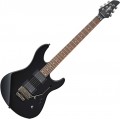Pickups
Type of pickups used in electric guitar.
—
Passive. Passive pickups are called pickups that do not use their own power supply. Such devices produce a weak signal, so guitars with passive pickups require an external preamp. In terms of sound, many musicians consider passive pickups to be more "natural" and dynamic, but this point is largely subjective. The unequivocal advantage of this option is the extensive features for experimenting with the technique of sound extraction. In addition, passive modules are much simpler and cheaper than active modules, and they do not require their own power supplies. On the other hand, these pickups are subject to feedback, which can be problematic in some situations. Yes, and sensitivity to pickups (and, accordingly, the likelihood of interference) they are significantly higher.
—
Active. Pickups supplemented with built-in preamps to increase the level of the signal fed to the output of the instrument. Thanks to the additional amplification, many models have fewer coil turns than passive models, which reduces interference and provides a cleaner and more balanced signal. At the same time, the active module retains the upper frequencies better; this gives the effect of "brightness", "transparency" of the sound. However there is an opinion that this sound turns out to be unnatural, but this moment, again, is largely subjective. But from the unequivocal disad
...vantages of active pickups, one can note the need for their own power source. One of the most popular options for this is a 9V battery, which is installed in a special compartment in the body of the guitar.Type
The type of tone block used in the construction of an electric guitar.
A timbre block is an “intermediary” between a pickup and a guitar output: a set of electronic circuits that provides signal transmission, and often also its processing (volume control, frequency correction, preamplification, etc.). In modern electric guitars, there are such types of tone blocks:
— Passive. Passive are called timbre blocks that do not require additional power sources during operation. Usually, such modules have the simplest design and functionality, adjustments are limited to changing the volume, as well as passively correcting frequencies (by “cutting off” the desired frequencies). At the same time, passive tone blocks are simple, compact, inexpensive and do not depend on batteries; and the necessary adjustments can be made on external equipment (anyway, the electric guitar will need to be connected to it). As a result, most modern instruments are equipped with this particular type of tone blocks.
—
Active. The key difference between a passive tone block is that it needs its own power source to work. Most often, this role is played by a PP3-type battery installed in a special socket in the body of an electric guitar. The need for power is due to the abundance of additional functions: active tone blocks are able to amplify the signal coming from the pickups, suppress interference, and even match the output impedance of the inst
...rument with the input of the amplifier. Yes, and the active method of tone control is more advanced than the passive one, it allows you to more accurately adjust the frequency ratio. On the other hand, active modules are noticeably more expensive, and without a battery, the tone block turns into a set of useless parts. However, such devices consume relatively little energy, and one battery lasts for quite a long time.
— Active/passive. Tone blocks that combine the capabilities of the two options described above. If there is power, such a module operates in active mode, and if there is no power, it turns into passive. Thus, the musician can enjoy all the advantages of the active tone block and at the same time not worry that the instrument will become completely useless due to a dead battery (although, of course, the tone block functionality is not so extensive in the passive mode). At the same time, combined modules are quite complex and expensive, and the real need for such versatility is rare. Therefore, this option has not received much distribution.Fretboard radius
The radius of curvature of a fretboard mounted on the fretboard of an electric guitar.
The fingerboard is located directly under the strings, it is to it that the musician presses the strings when playing. If you look at the neck in cross section, its upper part with the overlay will have the shape of an arc; the radius of this arc is implied in this case. The smaller the radius, the more convex this arc will be, and vice versa, a large radius will correspond to an almost flat surface.
In general, it is believed that a smaller fingerboard radius is better for playing chords, and a more even, flat surface makes it easier to play technical passages with an abundance of special techniques such as bands. The average and, one might say, classic diameter value is 12", this is the most popular option among modern electric guitars. The smallest figure is just over 7", it is found in some guitars with Stratocaster bodies (both original Fender instruments and copies ). And the most flat pads have a diameter of 20" or more.
Note that there are often instruments with a variable fretboard radius — smaller at the headstock (where chords are played more often) and larger near the body (where solos are played by notes). In such cases, the radius at the nut is indicated.

